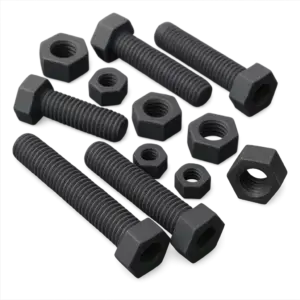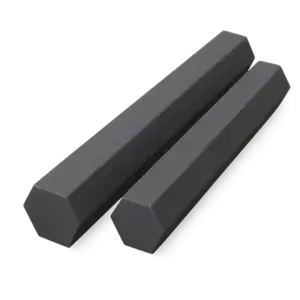Properties and Advantages of PVC-U Screws and Nuts
High chemical resistance
Ideal for use in aggressive environments with acids, alkalis, or salts.
Corrosion-free
No rusting or oxidation – even after years of use in humid or saline environments.
Low weight
Significantly lighter than metal fasteners, leading to considerable weight savings in machines and constructions.
Electrical insulation
Excellent insulation properties, ideal for electrical and automation technology.
Easy processing
PVC-U screws are easy to install and remove – without complex tools.
Typical Industries and Areas of Application
Chemical and Pharmaceutical Industry
Applications:
• Assembly of pipes, containers, and pump systems in chemical plants
• Fastening of plastic fittings in laboratories and production facilities
• Use in ultra-pure water systems, as PVC-U does not release contaminants
Advantage: High resistance to acids, alkalis, and solvents
Water and Wastewater Technology
• Fittings in cooling circuits, filtration systems, and pump systems
• Connections in water treatment plants (e.g., for drinking water or industrial processes)
• Use in saltwater or chlorine pools (swimming pool technology)
Advantage: No corrosion or material degradation due to water or cleaning chemicals
Electrical and Automation Technology
Areas of application:
• Use as electrically insulating screws and nuts in control cabinets
• Fastening of insulators and plastic housings in high-voltage systems
• Use in sensitive areas of electronics manufacturing
Advantage: High insulation properties without affecting electronic components
Mechanical and Plant Engineering
Areas of application:
• Screw connections in mechanical engineering constructions where metal connections are unsuitable
• Fastening of lightweight elements in conveyor technology, packaging machines, or medical technology
• Reduction of mechanical vibrations and noise development
Advantage: PVC-U screws are lightweight, vibration-damping, and ensure a durable connection
Shipbuilding and Offshore Technology
Areas of application:
• Fasteners in saltwater environments (e.g., boat building, offshore platforms, port facilities)
• Assembly of corrosion-free plastic components on ships and yachts
Advantage: Absolute corrosion resistance, even with long-term exposure to saltwater
Manufacturing Process of Screws and Nuts from PVC-U Hexagonal Bars
The production of screws and nuts from AKU®-DUR PVC-U hexagonal bars takes place in several precise steps to ensure high quality and mechanical stability. Various machining processes such as turning, milling, and thread cutting are used.
Material Selection and Cutting
Starting material:
The production begins with the selection of high-quality PVC-U hexagonal bars in the appropriate diameter and length dimensions. These bars are characterized by high dimensional stability, chemical resistance, and good processability.
Cutting:
The hexagonal rods are sawed or cut to the appropriate length according to the desired screw or nut size. Precise dimensional accuracy is ensured to guarantee uniform further processing.
Turning and Milling of Screw Heads and Nuts
Shaping of Screws:
• The cut PVC-U rod is clamped in a lathe to prepare the screw head and thread profile.
• The head shape can be designed as hexagonal, flat head, or round head as needed.
Processing of Nuts:
• Nuts are machined from the hexagonal rod using a milling machine.
• Subsequently, a hole is drilled for the internal thread.
Thread Cutting or Forming
Cutting the External Thread (Screws):
• The external thread of the screw is applied using a thread cutting tool or thread turning process.
• Precise control ensures a clean and dimensionally accurate thread structure.
Cutting the Internal Thread (Nuts):
• The internal thread is cut in the pre-drilled nuts using a tap, ensuring a perfect fit with the screw.
• Alternatively, the thread can be manufactured by milling.
Final Processing and Quality Control
Smoothing and Deburring:
• After thread production, screws and nuts are carefully deburred to remove sharp edges.
• Surface finishing can be applied to reduce friction and increase durability.
Quality Inspection:
• The manufactured screws and nuts are checked for dimensional accuracy, thread precision, and mechanical load capacity.
• In addition to visual inspection, mechanical load testing may be performed.
Conclusion:
The manufacturing process of screws and nuts from AKU®-DUR PVC-U hexagonal rods combines precise mechanical processing with high material quality.
Thanks to the easy formability of PVC-U, robust and durable fasteners can be produced that are chemically resistant, corrosion-free, and lightweight – an ideal alternative to conventional metal connections.


